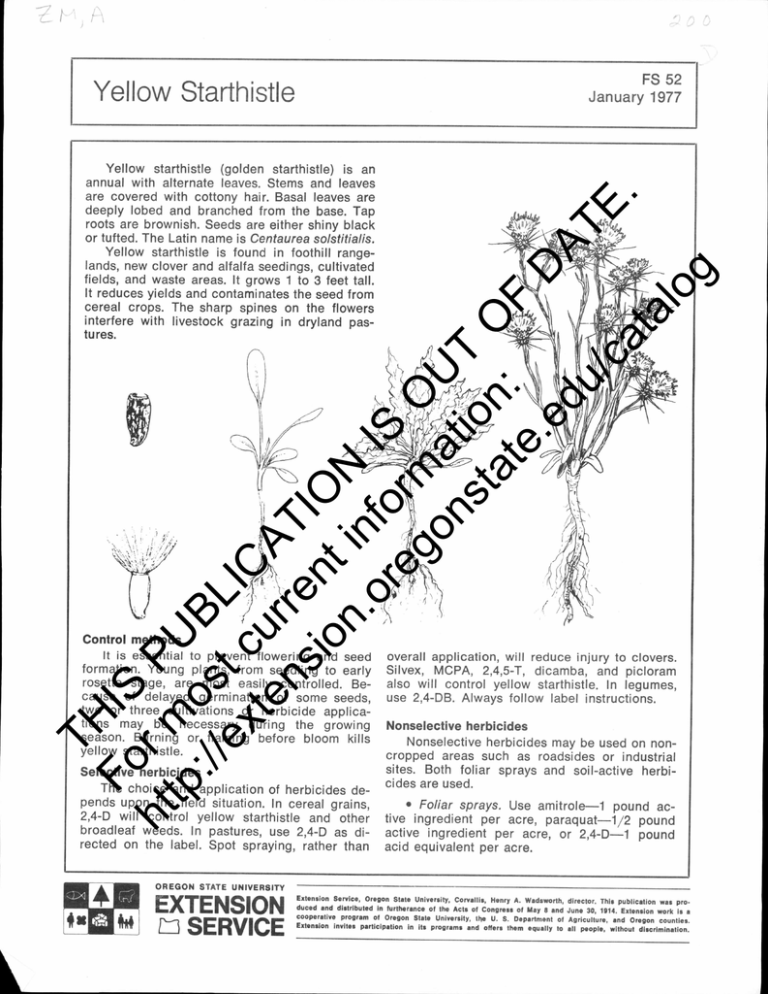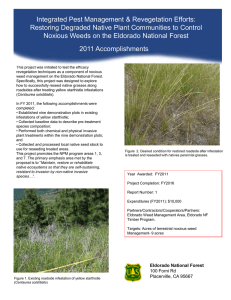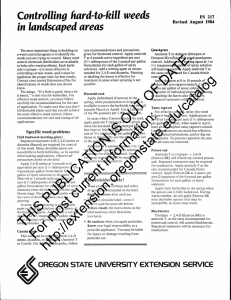Yellow Starthistle January 1977
advertisement

4? 0 cr.) FS 52 January 1977 Yellow Starthistle Fo IS ht r m P U tp o :// s BL ex t c IC te ur A ns re TI io nt ON n. in or fo IS eg rm O on at U st ion T O at : F e. D ed A u/ TE ca . ta lo g Yellow starthistle (golden starthistle) is an annual with alternate leaves. Stems and leaves are covered with cottony hair. Basal leaves are deeply lobed and branched from the base. Tap roots are brownish. Seeds are either shiny black or tufted. The Latin name is Centaurea solstitialis. Yellow starthistle is found in foothill rangelands, new clover and alfalfa seedings, cultivated fields, and waste areas. It grows 1 to 3 feet tall. It reduces yields and contaminates the seed from cereal crops. The sharp spines on the flowers interfere with livestock grazing in dryland pas- tures. Control methods It is essential to prevent flowering and seed formation. Young plants, from seedling to early overall application, will reduce injury to clovers. Silvex, MCPA, 2,4,5-T, dicamba, and picloram also will control yellow starthistle. In legumes, use 2,4-DB. Always follow label instructions. TH rosette stage, are most easily controlled. Because of delayed germination of some seeds, two or three cultivations or herbicide applications may be necessary during the growing Nonselective herbicides season. Burning or flaming before bloom kills Nonselective herbicides may be used on nonyellow starthistle. cropped areas such as roadsides or industrial sites. Both foliar sprays and soil-active herbiSelective herbicides The choice and application of herbicides depends upon the field situation. In cereal grains, cides are used. Foliar sprays. Use amitrole-1 pound ac2,4-D will control yellow starthistle and other tive ingredient per acre, paraquat-1/2 pound broadleaf weeds. In pastures, use 2,4-D as di- active ingredient per acre, or 2,4-D-1 pound rected on the label. Spot spraying, rather than acid equivalent per acre. OREGON STATE UNIVERSITY EXTENSION r-) SERVICE Extension Service, Oregon State University, Corvallis, Henry A. Wadsworth, director. This publication was Produced and distributed in furtherance of the Acts of Congress of May 8 and June 30, 1914. Extension work is a cooperative program of Oregon State University, the U. S. Department of Agriculture, and Oregon counties. Extension invites participation in its programs and otters them equally to all People, without discrimination. Use 1 quart of wetting agent per 100 gallons water with amitrole, paraquat, and 2,4-D amine formulations. Use 40 to 50 gallons of water per acre. If you use amitrole, for example, apply of 40 to 50 gallons of spray per acre, containing pound active material and a half-quart of 1 wetting agent. Soil-active herbicides. These materials give tion. Pesticide warning The user of any pesticide is responsible for residues in a crop or for problems caused by drift from one property to other property or crops. Always follow the label instructions. Drawings, and some of the information included in this Fact Sheet, appear courtesy of University of TH Fo IS ht r m P U tp o :// s BL ex t c IC te ur A ns re TI io nt ON n. in or fo IS eg rm O on at U st ion T O at : F e. D ed A u/ TE ca . ta lo g season-long weed control. They should not be applied where roots of desirable plants may be present. Rainfall is necessary to leach these chemicals into the soil before the weeds are up. Use atrazine (AAtrex ®), simazine (Princep ®), bromacil (Hyvar X ®), diuron (Karmex ®), karbutilate (Tandex ®), or monuron (Telvar 0) at 2.4 to 4 pounds active ingredient per acre. This will be 3 to 5 pounds of 80 percent formula- California Extension Leaflet 2741. Revised by Martin Zimmerman, Gilliam County Extension agent, and Homer M. Hepworth, Extension agronomist, Oregon State University.


